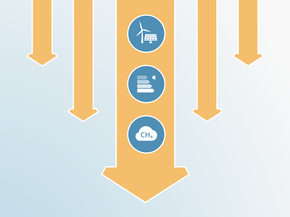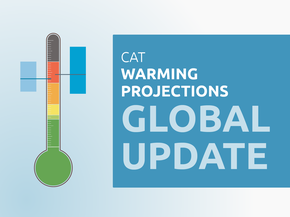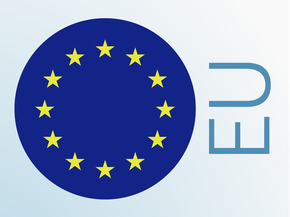Assumptions
Historical emissions
Historical emissions levels are taken from the latest national inventory data submitted to the UNFCCC in 2025, with the latest available year being 2023 (Russian Federation, 2025a).
NDC and other targets
2030 target
We have updated our methodology for quantifying Russia’s targets in response to Russia’s significant recalculation of its historical LULUCF emissions in its National Inventory Report from 2024. We have decided to treat Russia’s targets for 2030, 2035, 2050, and 2060 as commitments from a specific point in time, so we use the national documents available at the time the target was communicated. We also consider a LULUCF range to accommodate for the uncertainty of Russia’s LULUCF projections.
We use 1990 emissions including LULUCF, or 3110 MtCO2e in Global Warming Potential Values (GWP) from the Fourth Assessment Report (AR4), as communicated in the National Inventory Report from April 2020 because it aligns with the 1990 base year indicator of 3.1 billion tons of CO2e (incl. LULUCF) reported in the NDC that was submitted that same year. We convert 1990 emissions into GWP from the Fifth Assessment Report (AR5) using a gas-by-gas conversion method and apply a 30% reduction.
The CAT excludes LULUCF emissions from its calculations, so we remove the estimated LULUCF sink in 2030 from the value indicated above. Since the 2030 NDC does not provide projections for LULUCF emissions, we construct a range for the LULUCF sink using the "With measures" scenario and the "With additional measures" scenario as reported in Russia’s Fourth Biennial Report (Russian Federation, 2022a, 2025a). We use this Biennial Report because those are the LULUCF projections that existed at the time the NDC was submitted in 2020.
2035 target
Russia’s 2035 NDC includes LULUCF in the emission levels for both the base and target years.
In response to Russia’s significant recalculation of its historical LULUCF emissions in its National Inventory Report from 2024, the CAT has updated the methodology for quantifying Russia’s targets. We have decided to treat Russia’s targets for 2030, 2035, 2050, and 2060 as commitments from a specific point in time, so we base our quantifications on the national documents available at the time the target was communicated.
The CAT excludes LULUCF emissions from its calculations and removes the estimated contribution of the LULUCF sink from the target values. For the 2035 target, we use 1990 emissions including LULUCF, or 2,427 MtCO2e as reported in the 2035 NDC, calculated using the Fifth Assessment Report (AR5) GWP values, and apply a 33–35% reduction.
Since Russia’s 2035 NDC does not provide projections for LULUCF emissions, we have constructed a range for the LULUCF sink to account for the uncertainty around Russia’s LULUCF projections. For this, we use the "With measures" and "With additional measures" scenarios as provided in Russia’s First Biennial Transparency Report (BTR1).
Current policy projections
For the lower bound of our current policy projections until 2035, we apply the growth rate of the 2024 World Energy Outlook (WEO) Stated Policy (STEPS) projections for CO2 from energy-related activities to Russia’s CO2 emissions from the latest historical year (IEA, 2024b). For non-CO2 emissions, we apply the US EPA’s projected growth rates to the latest historical year for each non-CO2 gas (EPA, 2025).
The upper bound of our current policy projections is based on the “With measures” (WEM) scenario outlined in the first version of Russia’s First BTR submitted to the UNFCCC (Russian Federation, 2025c). We applied the WEM sectoral growth rates to the latest historical year of emissions for each sector.
The CAT has not quantitatively assessed the long-term effect of Russia’s illegal invasion of Ukraine and its numerous implications, for example with regards to a decrease in fossil fuel exports or potential economic decline in Russia.
Net-zero target and other long-term targets
According to Russia’s Long-term Strategy, the LULUCF sink in 2050 would be -1200 MtCO2e. This value corresponds to the estimated sink under the “With additional measures” (WAM) scenario in Russia’s 8th National Communication (NC8) (Russian Federation, 2022a). Given the uncertainty around Russia’s LULUCF emissions, we create a range using the WEM and WAM projections for LULUCF in 2050 from Russia’s NC8. We convert the estimated LULUCF emissions in 2050 under these scenarios into GWP AR5 from GWP AR4 using a gas-by-gas conversion method.
For Russia’s 2050 target, we apply an 80% reduction to 1990 emissions including LULUCF. For the 1990 emissions level, we use what was communicated in the National Inventory Report from September 2023 (Russian Federation, 2023a). We convert the estimated 1990 emissions into GWP AR5 from GWP AR4 using a gas-by-gas conversion method. The CAT then removes the estimated LULUCF emissions in 2050 using the range outlined above.
For Russia’s 2060 net zero target, we assume that the range for the LULUCF sink in 2050 (-558 to 1199 MtCO2e) will remain constant until 2060 and that the sink will equate to Russia’s residual emissions (Russian Federation, 2022b). We make this assumption because Russia’s long-term strategy submission to the UNFCCC does not include a projection to 2060 which would outline the level of reductions that would be required to reach net zero emissions.
Global Warming Potentials
The CAT has begun to use Global Warming Potential (GWP) values from the IPCC's Fifth Assessment Report (AR5) for its figures and time series. Assessments completed prior to May 2025 used GWP values from the Fourth Assessment Report (AR4).
Further analysis
Latest publications
Stay informed
Subscribe to our newsletter




